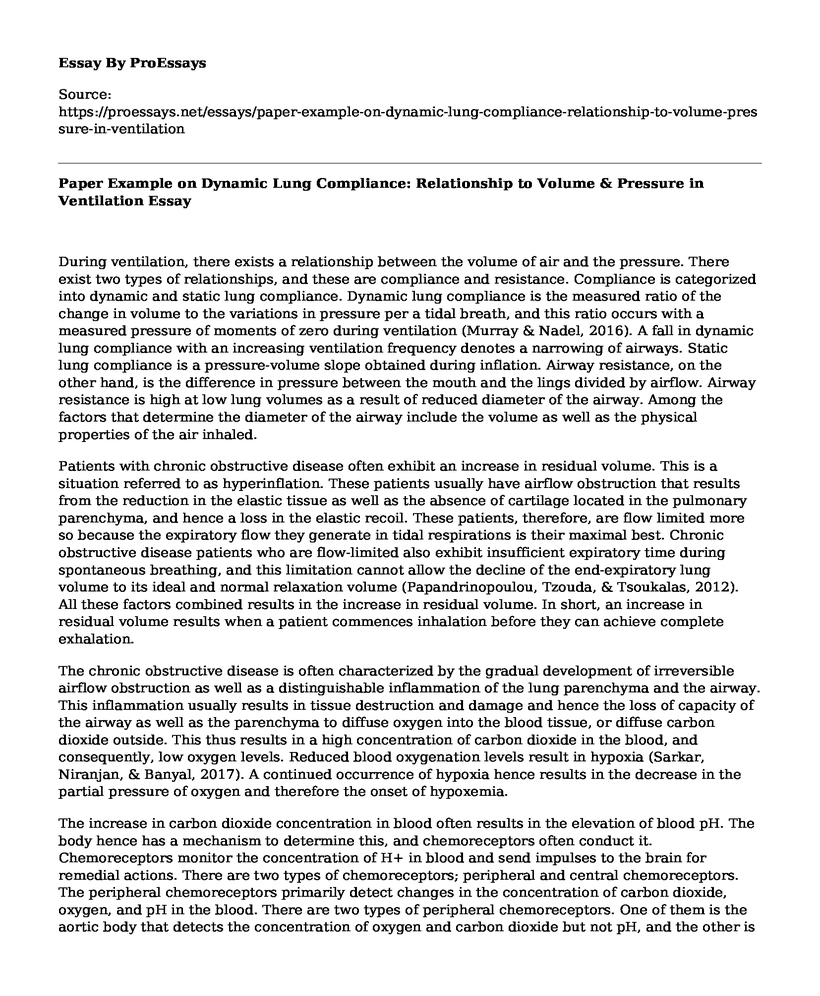During ventilation, there exists a relationship between the volume of air and the pressure. There exist two types of relationships, and these are compliance and resistance. Compliance is categorized into dynamic and static lung compliance. Dynamic lung compliance is the measured ratio of the change in volume to the variations in pressure per a tidal breath, and this ratio occurs with a measured pressure of moments of zero during ventilation (Murray & Nadel, 2016). A fall in dynamic lung compliance with an increasing ventilation frequency denotes a narrowing of airways. Static lung compliance is a pressure-volume slope obtained during inflation. Airway resistance, on the other hand, is the difference in pressure between the mouth and the lings divided by airflow. Airway resistance is high at low lung volumes as a result of reduced diameter of the airway. Among the factors that determine the diameter of the airway include the volume as well as the physical properties of the air inhaled.
Patients with chronic obstructive disease often exhibit an increase in residual volume. This is a situation referred to as hyperinflation. These patients usually have airflow obstruction that results from the reduction in the elastic tissue as well as the absence of cartilage located in the pulmonary parenchyma, and hence a loss in the elastic recoil. These patients, therefore, are flow limited more so because the expiratory flow they generate in tidal respirations is their maximal best. Chronic obstructive disease patients who are flow-limited also exhibit insufficient expiratory time during spontaneous breathing, and this limitation cannot allow the decline of the end-expiratory lung volume to its ideal and normal relaxation volume (Papandrinopoulou, Tzouda, & Tsoukalas, 2012). All these factors combined results in the increase in residual volume. In short, an increase in residual volume results when a patient commences inhalation before they can achieve complete exhalation.
The chronic obstructive disease is often characterized by the gradual development of irreversible airflow obstruction as well as a distinguishable inflammation of the lung parenchyma and the airway. This inflammation usually results in tissue destruction and damage and hence the loss of capacity of the airway as well as the parenchyma to diffuse oxygen into the blood tissue, or diffuse carbon dioxide outside. This thus results in a high concentration of carbon dioxide in the blood, and consequently, low oxygen levels. Reduced blood oxygenation levels result in hypoxia (Sarkar, Niranjan, & Banyal, 2017). A continued occurrence of hypoxia hence results in the decrease in the partial pressure of oxygen and therefore the onset of hypoxemia.
The increase in carbon dioxide concentration in blood often results in the elevation of blood pH. The body hence has a mechanism to determine this, and chemoreceptors often conduct it. Chemoreceptors monitor the concentration of H+ in blood and send impulses to the brain for remedial actions. There are two types of chemoreceptors; peripheral and central chemoreceptors. The peripheral chemoreceptors primarily detect changes in the concentration of carbon dioxide, oxygen, and pH in the blood. There are two types of peripheral chemoreceptors. One of them is the aortic body that detects the concentration of oxygen and carbon dioxide but not pH, and the other is the carotid body which monitors and detects oxygen and carbon dioxide concentrations as well as PH (Lumen, n. d). Central chemoreceptors are used to detect the variation in the pH of the spinal fluid. They are found on the medulla oblongata (on the ventrolateral surface), and they are often desensitized from increased carbon dioxide and chronic hypoxia. The peripheral chemoreceptors do not desensitize.
Conclusion
The chronic obstructive disease is a respiratory disorder that is often accompanied by an inflammation of the parenchyma and the airway. This hence causes a problem in the diffusion of oxygen and carbon dioxide, causing hypoxia. The chemoreceptors are hence used to monitor and detect these levels.
References
Papandrinopoulou, D., Tzouda, V., & Tsoukalas, G. (2012). Lung compliance and chronic obstructive pulmonary disease. Pulmonary medicine. 542769. doi:10.1155/2012/542769
Respiration control. Lumen. Retrieved from https://courses.lumenlearning.com/boundless-ap/chapter/respiration-control/
Sarkar, M., Niranjan, N., & Banyal, P. K. (2017). Mechanisms of hypoxemia. Lung India: official organ of Indian Chest Society, 34(1). Pp.47-60. doi:10.4103/0970-2113.197116
Warren M. Gold MD, Laura L. Koth MD in Murray J. F. & Nadel J. A. (2016). Murray and Nadel's Textbook of Respiratory Medicine. 6th edition. Elsevier Inc.
Cite this page
Paper Example on Dynamic Lung Compliance: Relationship to Volume & Pressure in Ventilation. (2023, Jan 24). Retrieved from https://proessays.net/essays/paper-example-on-dynamic-lung-compliance-relationship-to-volume-pressure-in-ventilation
If you are the original author of this essay and no longer wish to have it published on the ProEssays website, please click below to request its removal:
- Critical Health Implications of Pneumonia Research Paper
- Strategies for Improving Latino Healthcare in America Video Response
- Reflective Essay on Volunteerism in Hunger Resource Center
- Paper Example on Client BMI 33.8930Kg: Obesity Risk High
- Essay Sample on Humanitarian Pooled Funds: Financing Global Emergencies
- Paper Example on 30-Day Challenge: Get 6 Hours of Sleep & Improve Lifestyle
- Essay Sample on Oral Health: Global Prevalence, Dental Caries, Oral Cancer







